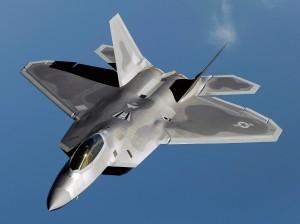Going back thousands of years, technology has played a major role in the defense of a nations and territories. From the Romans using hydraulic cement or concrete 2,500 years ago to fortify their cities from attack, to precision satellite guided weapons used in Iraq and Afghanistan today by the U.S. military, technology is almost as important as the actual strategies used behind any offensive or defensive maneuver.
The two super powers in the world today, could be said to be the United States and China. Although both countries have somewhat friendly relations, that doesn’t mean a power struggle has not erupted between the two nations over the last decade or two. The United States is known for their superior air power, with extremely advanced aircraft, such as the F-22 Raptor, and the B-2 stealth bomber, among others. In fact, the F-22 Raptor is considered the most technologically advanced aircraft in the world.
China, obviously isn’t happy with such a claim, so they have set out to create their own advanced fighter jets, in an attempt to be able to control the Asian Pacific sky in the event of a conflict. Recently unveiled earlier this year, the J-25 ‘Ghost Bird’ is claimed by the Chinese military to have the capability to shoot down any aircraft in the United States’ arsenal within second. This includes the F-22 Raptor. Of course, such a claim can not be verified at this time, and military technology remains quite secretive.
A recent report out of China indicates that the J-25’s superiority over the F-22 Raptor has a lot to do with the 3D printing technology used within the production of the advanced fighter jet. The J-25 is reportedly faster, and has greater undectability than that of the United States fighter. The aircraft, produced by the Chengdu Aviation Corporation, reportedly uses 3D printing for several key parts, leading to a lighter weight, while remaining extremely  durable and strong. The ability to hide from enemy radar, while remaining extremely agile to maneuver, can also reportedly be credited, at least in part, to 3D printing. The aircraft weighs approximately 20 tons, and it is said that additive manufacturing was used to make at least part of the fuselage.
durable and strong. The ability to hide from enemy radar, while remaining extremely agile to maneuver, can also reportedly be credited, at least in part, to 3D printing. The aircraft weighs approximately 20 tons, and it is said that additive manufacturing was used to make at least part of the fuselage.
Although it may be years before knowing the extend of the technology used within these Chinese fighter jets, such a plane is a key reason why government funding of new technologies, like that of additive manufacturing, is so very important. Such funding could lead to advances which will eventually make their way into the private sector of the economy. Whether the J-25 and its 3D printed components could outfight the F-22, we hopefully will never know, but if these reports do anything, it will likely push the U.S. into even more research into additive manufacturing technologies.
Let’s hear your opinion on the J-25 fighter jet, and its uses of additive manufacturing to possibly out maneuver the pride of the United States Airforce, the F-22, in the Chinese Fighter Jet forum thread on 3DPB.com.
[Source: 3dFocus]
Subscribe to Our Email Newsletter
Stay up-to-date on all the latest news from the 3D printing industry and receive information and offers from third party vendors.
You May Also Like
Gorilla Sports GE’s First 3D Printed Titanium Cast
How do you help a gorilla with a broken arm? Sounds like the start of a bad joke a zookeeper might tell, but it’s an actual dilemma recently faced by...
Nylon 3D Printed Parts Made More Functional with Coatings & Colors
Parts 3D printed from polyamide (PA, Nylon) 12 using powder bed fusion (PBF) are a mainstay in the additive manufacturing (AM) industry. While post-finishing processes have improved the porosity of...
$25M to Back Sintavia’s Largest Expansion of Metal 3D Printing Capacity Since 2019
Sintavia, the digital manufacturing company specializing in mission-critical parts for strategic sectors, announced a $25 million investment to increase its production capacity, the largest expansion to its operations since 2019....
Velo3D Initiates Public Offering in a Bid to Strengthen Financial Foundations and Drive Future Growth
Velo3D (NYSE: VLD) has been among a number of publicly traded 3D printing firms that have attempted to weather the current macroeconomic climate. After posting a challenging financial report for 2023,...































